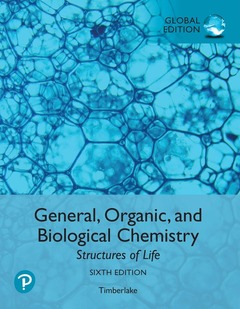Description
General, Organic, and Biological Chemistry: Structures of Life, Global Edition (6th Ed.)
Author: Timberlake Karen
Language: English
Subject for General, Organic, and Biological Chemistry: Structures...:
936 p. · 21.6x27.4 cm · Paperback
Description
/li>Contents
/li>Comment
/li>
For courses in General, Organic, and Biological Chemistry
General, Organic, and Biological Chemistry: Structures of Life engages students by helping them see the connections between chemistry, the world around them, and future health-related careers. Known for its friendly writing style, student focus, robust problem-solving pedagogy, and engaging health-related applications, the text prepares students for their careers. The text breaks chemical concepts and problem solving into clear, manageable pieces to ensure students stay on track and motivated throughout their first, and often only, chemistry course.
With the newly revised 6th Edition, best-selling author Karen Timberlake and new contributing author MaryKay Orgill connect chemistry to real-world and career applications. Their goal is to help students become critical thinkers by understanding scientific concepts that will form a basis for making important decisions about issues concerning health and the environment and their intended careers.
The new edition introduces more problem-solving strategies, more problem-solving guides, new Analyse the Problem with Connect features, new Try It First and Engage features, conceptual and challenge problems, and new sets of combined problems?all to help students develop the problem-solving skills they?ll need beyond the classroom.
1. Chemistry in Our Lives
2. Chemistry and Measurements
3. Matter and Energy
4. Atoms and Elements
5. Nuclear Chemistry
6. Ionic and Molecular Compounds
7. Chemical Reactions and Quantities
8. Gases
9. Solutions
10. Reaction Rates and Chemical Equilibrium
11. Acids and Bases
12. Introduction to Organic Chemistry: Hydrocarbons
13. Alcohols, Phenols, Thiols, and Ethers
14. Aldehydes and Ketones
15. Carbohydrates
16. Carboxylic Acids and Esters
17. Lipids
18. Amines and Amides
19. Amino Acids and Proteins
20. Enzymes and Vitamins
21. Nucleic Acids and Protein Synthesis
22. Metabolic Pathways for Carbohydrates
23. Metabolism and Energy Production
24. Metabolic Pathways for Lipids and Amino Acids
Career Focus Engages Students
- New and Updated - Chapter-opening Clinical Career focus provide engaging stories relating how chemistry is used daily in contemporary health-related professions and introduce the chemical concepts in each chapter. The chapter openers are now more clinically oriented with each story revisited with a Clinical Update at the end of chapter.
- New - Clinical Updates appears in the end-of-chapter material for each chapter and revisits the story from the Chapter-opening Career focus in the context of the chemistry learned in the chapter. Clinical Updates describe the follow-up treatment and provide additional application problems. Icons throughout the text highlight Clinical Update problems and provide examples of how allied health professionals use chemistry daily in their careers.
- New - Clinical Applications added to Practice Problems show the relevance between the chemistry content and medicine and health.
- Chemistry Links to Health and Environment throughout the text relate chemistry concepts to real-life topics in health, the environment, and medicine that interest students.
- Updated - Practice Problems, Sample Problems, and art demonstrate the connection between the chemistry being discussed and how these skills will be needed in professional experience.
Builds Students’ Critical-Thinking and Problem-Solving Skills
- New - Review topics appear in the margin at the beginning of a Section, listing the Key Math Skills and Core Chemistry Skills from the previous chapters.
- New - Engage feature in the margin asks students to think about the paragraph they are reading and to test their understanding by answering the Engage question.
- New - Strategies for Learning Chemistry describe s




